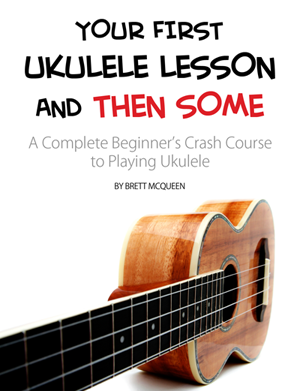In this lesson, I show you five strumming patterns you can use to play thousands of different songs on ukulele (I’m not exaggerating!). These are my “go to” strumming patterns. I use them all the time and have used them in a lot of video performances on the site (e.g. You’ve Got a Friend In Me, I’ve Been Working On the Railroad). These patterns are versatile, simple and work for most songs.
Note: A few of these strumming patterns are taught in the Strumming Tricks video lesson course. For sake of brevity, in this lesson, I won’t go into as much detail explaining these patterns as I would in my course. If you are looking for a progressive easy-to-follow, step-by-step practice plan towards becoming a better strummer with deeper explanations, I highly recommend my Strumming Tricks course.
Foundations of Strumming
The first thing to realize about strumming is that it’s not about how fancy or complicated you make a strumming pattern. Since strumming is a form of rhythm, in order to be effective, it must be consistent and steady. A steady, consistent strumming rhythm is always more pleasing to listen to than a really complicated strumming pattern played out of time.
The following strumming patterns, as demonstrated in the video, are played in 4/4 time signature. This means each pattern is played to a steady, consistent count of four: 1, 2, 3, 4, repeat. You can use these patterns for any song counted in four. As you practice each of these strumming patterns, count out loud, and even use a metronome to keep your strumming as rocksteady as possible.
Strumming Pattern #1

Before learning any other strumming pattern, learn this one. This pattern is very simple, as it is only down strums, but it is highly effective. For example, in my performance of Leonard Cohen’s “Hallelujah”, I use all down strums for the last half of the song.
As you practice this, set your metronome, count out loud, and focus on lining up your down strums with each beat. Try to make your strums as even in tone and in volume.
Strumming Pattern #2

When you have the previous pattern mastered, add in up strums between each down strum to make the pattern more interesting. You would count these up strums in between the main beats by counting the word “and” like: 1 and, 2 and, 3 and, 4 and, repeat.
In addition, practice changing between chords on the first beat of the strumming pattern. For example, you might switch between a C, Am, and F chord. Take your practice further by coming up with your own chord progressions too.
Strumming Pattern #3

This strumming pattern combines the first two patterns. For this pattern, insert an up strum on the “and” of beats 2 and 4.
Strumming Pattern #4

You can get creative by rearranging the order of your down strums and up strums within the count of four. This pattern is like pattern #3, but in this pattern, you insert an up strum on the “and” of beats 1 and 3.
Strumming Pattern #5

This strumming pattern is sometimes referred to as the calypso strum. This pattern is the most complicated out of all of the patterns. This is because the down strum on beat 3 is removed and you only play an up strum on the “and” of the third beat. You’ll want to be sure to watch the video to get a sense for how this pattern sounds and feels. Once you get it down, you’ll find that it’s an easy pattern to apply to a lot of different songs.
Practicing Strumming Patterns
I recommend practicing these strumming patterns while playing just a C chord. Strumming is all about practicing a pattern to the point where it comes second nature and you don’t have to think about it too much. Don’t forget to practice these strumming patterns at a slow and fast tempo.
After practicing each pattern for awhile, practice changing between chords. Check out my lesson “Knowing When to Change Chords While Strumming a Song” for some practice examples.
When you’re ready, try applying these strumming patterns to a few different songs:
How’s the strumming going for you? What questions do you have? I’d love to hear from you.
Post your comment below.

